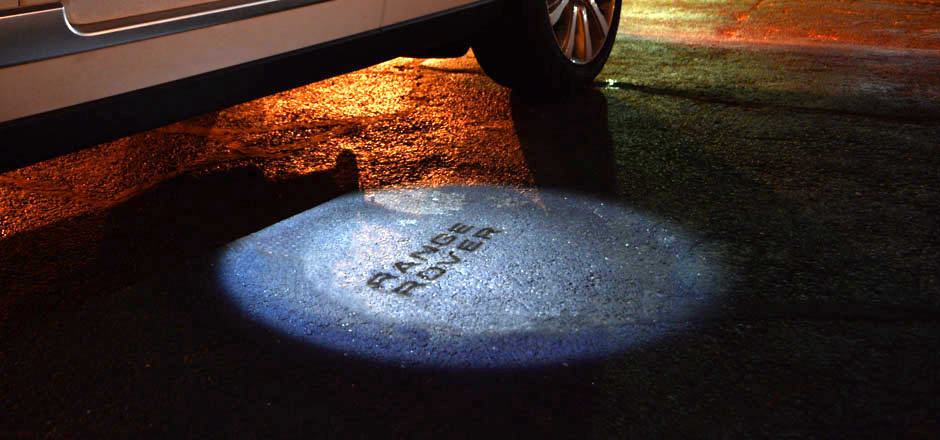{{ gallery "Exterior" }}
The new Rover is still ostensibly designed primarily as an off-road vehicle, but it's immediately clear who buys this car: The interior is still a study in wood and leather, but it's now muted and sleek—more like a first class lounge in a Danish airport than a fusty old hotel bar. At night, puddle lights illuminate the ground with Bat-Signal-like Range Rover wordmarks. An aluminum exterior and unibody construction saves 700 pounds over the outgoing vehicle, adding four inches of rear legroom and two thirds of an inch of ground clearance, while an eight-speed automatic cuts precious milliseconds off every shift.
{{brightcove '2632576414001'}}
I drove a Fuji White model with the 510-hp supercharged V8 under the hood. Where the previous car found me asking how something so heavy could be so fast, the new model got me wondering how such a massive vehicle could feel so light. Indeed, it was initially disconcerting how little effort it took to steer the car, or to instantaneously summon the kind of power that could result in a stern talking-to from the driver of a state-owned Crown Vic. Sure, there's some wallow in turns and brake dive, but it's a 2.6-ton off-roader, not a mid-engined sports car. Agility is a bonus, not a requirement.
Also disconcerting was just how easily the Rover handled rough terrain. I took it on a short trail that would've been a mild challenge for even most crossovers, but the Range Rover plowed through like it was a freshly-paved driveway. Eight-inch drops, sandy surfaces, and hidden tree branches? No problem. You'll never back out of a parking space again. Just hop the curb and drive over the median.
{{brightcove '2632544485001'}}
The new Rover even got some much-needed tech updates, including an automated parallel parking feature and automatic terrain response selection. Unfortunately, that's where the engineers left off, and it's still saddled with the same lousy Jaguar Land Rover infotainment system we've learned to hate over the years. That's unacceptable for a vehicle that starts at $83,545 and soars well past $135k, especially considering what kind of tech the competition offers.
Sure, the system looks nice at first glance. The screen shows a quick summary of navigation, audio, and phone information. Physical buttons control often-used functions, including an astounding Meridian audio system with a subwoofer that will rattle you more than a desert trail. But once you've got the touch screen open, button presses are sluggish, USB playlist integration is lackluster, and graphics aren't nearly detailed enough.
{{ gallery "Tech" }}
Worst of all, connectivity options are nil. You can make dinner reservations using voice recognition on a sub-$20,000 Toyota Prius C and stream Pandora on a $15,000 Chevy Spark, but the six-figure Rover is limited to what's been programmed into the nav system in the factory. Audi's got MMI, Mercedes has COMAND, Lexus' Enform costs extra but works well, and BMW's iDrive is better than ever. But Jaguar Land Rover has nothing but a serious deficit smack in the middle of the dashboard.
The tester I drove featured rear-seat screens, plus a wireless controller and headphones. But the only inputs were a DVD player, a USB port, and some RCA jacks. The 2014 Range Rover Sport features an optional embedded internet connection for passengers to connect their tablets, but the flagship Rover's connectivity options make it feel like a refugee from the '90s.
{{brightcove '2632672622001'}}
Even if off-road ability matters as much as infotainment, the 2014 Jeep Grand Cherokee pairs a new version of Chrysler's UConnect infotainment system with a comfortable interior and serious off-road chops. Fully loaded, it's still $30k less than the most basic Range Rover. You may laugh at the comparison, but here in New England where sensibility is almost as important as a car that can handle a harsh winter, I've met plenty of folks with Range Rover bank accounts and Grand Cherokees in the garage.
Speaking of Yankee frugality, a fully-loaded Subaru Legacy with EyeSight runs $36,220. I mention this because Subaru's got one of the best adaptive cruise control systems on the market. Just turn it on, steer the car, and forget about the fact you're stuck in traffic. The Range Rover's active cruise control, on the other hand, only works at speeds above 25 mph. Not a deal breaker, but a real oversight on a car that's otherwise so impressive—especially when better systems are on offer from nearly every car in its class.
For now, Range Rover buyers may overlook subpar infotainment. After all, there's so much else to enjoy. Some buyers may value heritage over high tech. But looks and history can only go far. Range Rover already proved it could breathe new life into the bones of a classic. Now, it needs to concentrate on the dashboard.
{{ gallery "Interior" }}
Meet the tester
Keith was the Editor in Chief of Reviewed's appliance and automotive sites. His work has appeared in publications such as Wired, Car & Driver, and CityLab.
Checking our work.
Our team is here to help you buy the best stuff and love what you own. Our writers, editors, and experts obsess over the products we cover to make sure you're confident and satisfied. Have a different opinion about something we recommend? Email us and we'll compare notes.
Shoot us an email

